For office use only
T1
T2
T3
T4
For office use only
F1
F2
F3
F4
Team Control Number
1907723
Problem Chosen
A
2019
MCM/ICM
Summary Sheet
Dragon in the Real World
Summary
In the Game of Thrones based on the epic fantasy novels A Song
of Ice and Fire, ”The Mother of Dragons”, Daenerys Targaryen raised
three dragons. Given that these dragons are living today, we’re going to
analyze dragon’s features, behaviors, habits, diet and interaction with
the environment. Our tasks mainly include the following four aspects:
1.Dragon’s characteristics; 2.Daily behaviors; 3.Interaction with ecolog-
ical system; 4.Environment’s support to the growth of the dragons.
We firstly build the dragon model, analyzing the dragon’s shape, behav-
iors and other characteristics. Then, we build an ecosystem model to
analyze the interaction between dragons and the environment.
In task 1, we conducted a comprehensive analysis and modeling of the
dragon in order to maximize the description of its physical characteris-
tics, including morphological features such as the weight, wingspan and
length of the body. In the analyzing of the weight of dragons, we used
the Gompertzcurve curve to model the change of the weight of dragons
over time.
In task 2, we analyzed dragon’s behaviors of flight, migration and fire
breathing. We also modeled the metabolism of dragons based on the
famous Kleiber’s law.
In task 3, we mainly analyzed a temperate deciduous broad-leaved for-
est ecosystem. Based on the species coexistence model by Tilman, we
established the Dragon’s invading model to analyze the interaction. We
came up with the concept of Development Index (DI) to measure the
development status of a group in the ecological system.
In task 4, we quantitatively analyzed the environmental requirements
for maintaining the growth of dragons.
Keywords: Gompertzcurve curve;Kleiber’s law;Dragon’s invading model
�
Team # 1907723
Page 1 of 21
Contents
1 Introduction
1.1 Background . . . . . . . . . . . . . . . . . . . . . . . . . . . . . . .
1.2 Restatement of the Problems
. . . . . . . . . . . . . . . . . . . . .
2 Notation
3 Dragon’s Characterisics
3.1 Analysis . . . . . . . . . . . . . . . . . . . . . . . . . . . . . . . . .
3.2 Body Characteristics . . . . . . . . . . . . . . . . . . . . . . . . . .
3.2.1 Weight . . . . . . . . . . . . . . . . . . . . . . . . . . . . . .
3.2.2 Wingspan . . . . . . . . . . . . . . . . . . . . . . . . . . . .
3.2.3 Body Length . . . . . . . . . . . . . . . . . . . . . . . . . .
3.2.4
summary . . . . . . . . . . . . . . . . . . . . . . . . . . . .
3.3 Physiological Characteristics-Metabolism . . . . . . . . . . . . . . .
3.4 Behaviors . . . . . . . . . . . . . . . . . . . . . . . . . . . . . . . .
3.4.1 Breath of Fire . . . . . . . . . . . . . . . . . . . . . . . . . .
3.4.2 Flight . . . . . . . . . . . . . . . . . . . . . . . . . . . . . .
4 Ecological System
4.2.1 Establishment of the Model
4.2.2
4.2.3
4.1 Assumption and Justification . . . . . . . . . . . . . . . . . . . . .
4.2 Model of Dragon’s invading . . . . . . . . . . . . . . . . . . . . . .
. . . . . . . . . . . . . . . . . .
Solution of the Model
. . . . . . . . . . . . . . . . . . . . .
Sensitivity Analysis . . . . . . . . . . . . . . . . . . . . . . .
4.3 Support from Ecological System . . . . . . . . . . . . . . . . . . . .
4.3.1 Energy Flaw . . . . . . . . . . . . . . . . . . . . . . . . . .
4.3.2 Energy Demand . . . . . . . . . . . . . . . . . . . . . . . .
5 Varying Environment
6 Conclusions
6.1 Strengths
6.2 Weaknesses
. . . . . . . . . . . . . . . . . . . . . . . . . . . . . . . .
. . . . . . . . . . . . . . . . . . . . . . . . . . . . . . .
3
3
3
3
3
3
4
4
4
5
6
6
6
6
7
8
8
10
10
11
12
13
13
14
15
16
16
16
�
Team # 1907723
7 Extensions
8 Letter to George R.R.Martin
Appendices
Appendix A First appendix
Appendix B Second appendix
Page 2 of 21
16
18
19
19
20
�
Team # 1907723
1 Introduction
Page 3 of 21
1.1 Background
In the TV series Game of Thrones, the three dragons, Dragon, Rhaegal, and Viserion
have attracted the attention of numerous fans with their tremendous power. We
were astounded by the dragon’s enormous size and destructive fire. However, what
about the authenticity of the dragon in the film? In this paper, we try to explore
the realistic basis of dragons, including their characteristics and their interaction
with the environment.
1.2 Restatement of the Problems
Given that dragons are living today, we need to construct models about their body
and behaviors to understand them. It’s no doubts that dragons which depend on
the ecosystem will have an impact on the ecosystem. To understand the interaction
between the enormous dragons and ecosystem, we need some models. Our specific
tasks are the following:
• Construct Model of the dragons , study the dragons’ shape, behaviors and
other characteristics.
• Establish ecosystem model and study the interaction between dragons and
environment.
• Consider other fields where the model can be used.
• Write a letter to the author of A Song of Ice and Fire, George R.R. Martin, to
provide guidance about how to maintain the realistic ecological underpinning
of the story.
2 Notation
Here we list some symbols and notations used in this paper,as shown in Tabel 1.
Others will be explained when used.
3 Dragon’s Characterisics
3.1 Analysis
Because of the illusory nature of the dragon being analyzed, we do not have enough
effective data to construct all the characteristics of the dragon, so we only give
some obvious characteristics of the dragon, such as weight, wingspan, body length,
�
Team # 1907723
Page 4 of 21
Table 1: Notations
Symbol Description
M
Ws
Ad
v
Ld
PBM R
The weight of the dragon
The wingspan of the dragon
The wingspan area of the dragon
The flight speed of the dragon
The length of the dragon
The baisc metabolic rate of the dragon
metabolic rate, flight, and fire breathing, which are enough to describe the dragon.
When analyzing the characteristics of the dragon, it is assumed that the dragon
can obtain sufficient external resources, and the external environment will not have
obvious influence on the growth of the dragon, and the dragon is only limited by
its own internal factors.
3.2 Body Characteristics
3.2.1 Weight
Firstly, we need to address the problem of the dragon’s weight, assuming that exter-
nal resources are sufficient and that the weight change of the dragon is only related
to the internal causes (biology) of the dragon. The Gompertzcurve[7] performs well
in fitting the growth process of organisms and is adopted by most biologists. We
use the Gompertzcurve to simulate the relationship between weight M (Kg) and
age t (years) during the growth of the dragons.
The expression of the Gompertzcurve is:
eabt
M = ke
(1)
Specific analytic expression will be given below.
3.2.2 Wingspan
Considering that the fictional dragons are similar with pterosaurs that existed in
the history, we use the biological studies on pterosaurs for reference to estimate the
physical characteristics of dragons. Based on the studies on pterosaurs by Stuart
Humphries, Richard h. C Bonser, Mark P Witton, David M Martill [1] and others,
we give the relationship between the wingspan and the body weight of dragons:
M = 0:299W 2:215
s
where M is weight, Ws is the width of the wingspan
(2)
The author,George R.R. Martin has said that The dragon is the size of a Boeing
747.We assume that after 10 years since hatching, the wingspan of the dragon
�
Team # 1907723
Page 5 of 21
reaches the wingspan of a Boeing 747, which is about 60m. Thus, we can obtain
the following set of equations:
eabt
M = ke
M = 0:299W 2:215
s
M (0) = 10
M (1) = 35
Ws(10) = 60
According to the equation set above, we can get the parameters: a=1.758, b=0.2432
and k= 3309. Figure 1 shows the change of dragon’s weight with time. The weight
increases rapidly when dragon is young. It still increases after the age of 20 but
not obvious. At the age of 10, dragon is already in his youth.
In the article of
Figure 1: Dragon’s weight
Stuart Humphries et al., pterosaur’s wingspan area calculation formula was given.
Similarly, the wingspan area of dragon can be expressed as:
Ad = 0:0886W 1:778
s
Ws is the wingspan area.
(3)
3.2.3 Body Length
The main function of the body length for flying animals is to maintain the stability
during flight. Based on the proportion of the body length and wingspan of birds in
the world, we give the proportion of the body length and wingspan of dragons:
Ld = 0:382Ws
Ld is the body length of dragon
(4)
�
Team # 1907723
3.2.4 summary
Page 6 of 21
The morphological characteristics of dragons are summarized in the Table 2.
Table 2: Morphological Feature of Dragon
e1:7580:2432t
s
M 3309e
M 0:299W 2:215
0:0886W 1:778
Ad
0:382Ws
Ld
s
For a 10-year-old dragon, the specific features are shown in Tabel 3.
Table 3: Morphological Feature of Dragon at the age of 10
M 2000 Kg
Ws
Ad
Ld
60 m
128 m2
23 m
3.3 Physiological Characteristics-Metabolism
In the biological field, studies on animal metabolism are relatively complete. Kleiber
summarized various metabolic models In Body size and metabolic rate[3]. We have
adopted the famous kleiber’s law[2] to simulate the metabolism level of dragons
in the resting state. Stuart Humphries et al.
studied the metabolism of many
pterosaurs, we have refered to their experimental data[1]. We then give the basic
metabolic rate(PBM R(Kcar/Day)) of the dragon:
PBM R = 50M 0:72
(5)
3.4 Behaviors
3.4.1 Breath of Fire
In this section, We mainly consider the maximum energy that can be released by
a dragon. Assuming that the maximum energy is equivalent to Ten Percent of
dragon’s weight, and that the heat required by a dragon to increase by 1Kg is H0
(H0 = 7000Kcal, the conversion ratio refers to human[4]). we use to represent
�
Team # 1907723
Page 7 of 21
the conversion coefficient of heat (Kcal) to energy (Kj). Then the maximum energy
that can be released by a dragon is:
E = 0:1M H0
(6)
For a 10-year-old dragon weighing 2000Kg, the maximum energy that can be re-
leased is:
E10 = 0:1 2000 7000 4:18 = 5:852 106Kj
(7)
The energy is equivalent to 1396Kg of TNT.
3.4.2 Flight
We mainly consider the energy problem faced by dragon. Considering the energy
consumption in the process of animals’flying go almost similar ( related to speed,
windward area and other factors),.We use pterosaurs’ flying to estimate dragon’s
energy consumption. Drawing on the work of Stuart Humphries and others (ref),
We give an expression for the energy consumption of a dragon in flight:
Pf = 0:5SCbv3 +
2kM 2g2
Wsv
+ C
(8)
Pf is calculated as power (W), is the air density, S is the projected frontal area
of the animal’s body (calculated as 8:13×10−3M 2
3 ), Cb is a coefficient related to
the dragon’s body resistance (0.75), v is the speed, k is the coefficient related to
the wing movement(1.2), M is the mass, W is the wingspan. C is a coefficient
associated with mass M[1].
For a 10-year-old dragon, M=2000Kg, W=60m, and C is calculated as 7.7 Kw.
The relation between power Pf and speed v is shown in Figure 2. When v equals
14.7385m/s, Pf gets the minimum value.
Considering that the dragon may take long-distance migration, we need to esti-
mate the maximum distance for dragon. For a 10-year-old dragon, assuming that
there is no energy supply or fire-breathing during the flight, the maximum energy
that can be consumed in one day’s flight is close to the maximum energy(E10) that
can be released in an instant which we have calculated in (7):
E10 = 5:852 105 Kj.
Assumed that the flying speed of the dragon is 14.7m/s(the minimum power con-
sumed), and the power is: Pf 0 = 1:5358 104 W.
From above, it can be calculated that the maximum flight distance(represented with
Sm) in a day is :
E10
Pf 0
= 10:6 Hour
t =
Sm = vt = 560127:6m
(9)
(10)
Consider three habitats: arid regions (25 degrees north latitude), warm temperate
regions (50 degrees north latitude), and the arctic (65 degrees north latitude).When
calculating the distance between the three regions in the process of migration, the
�
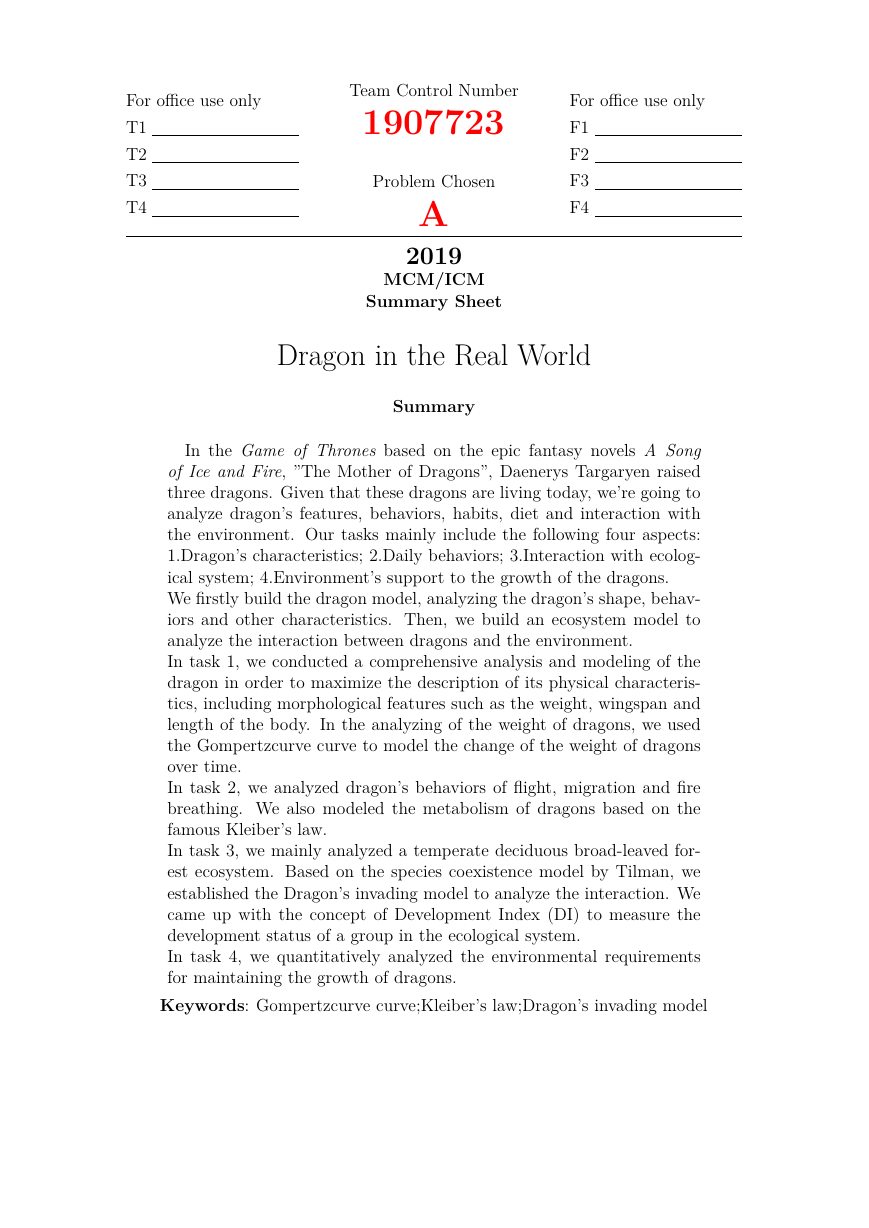
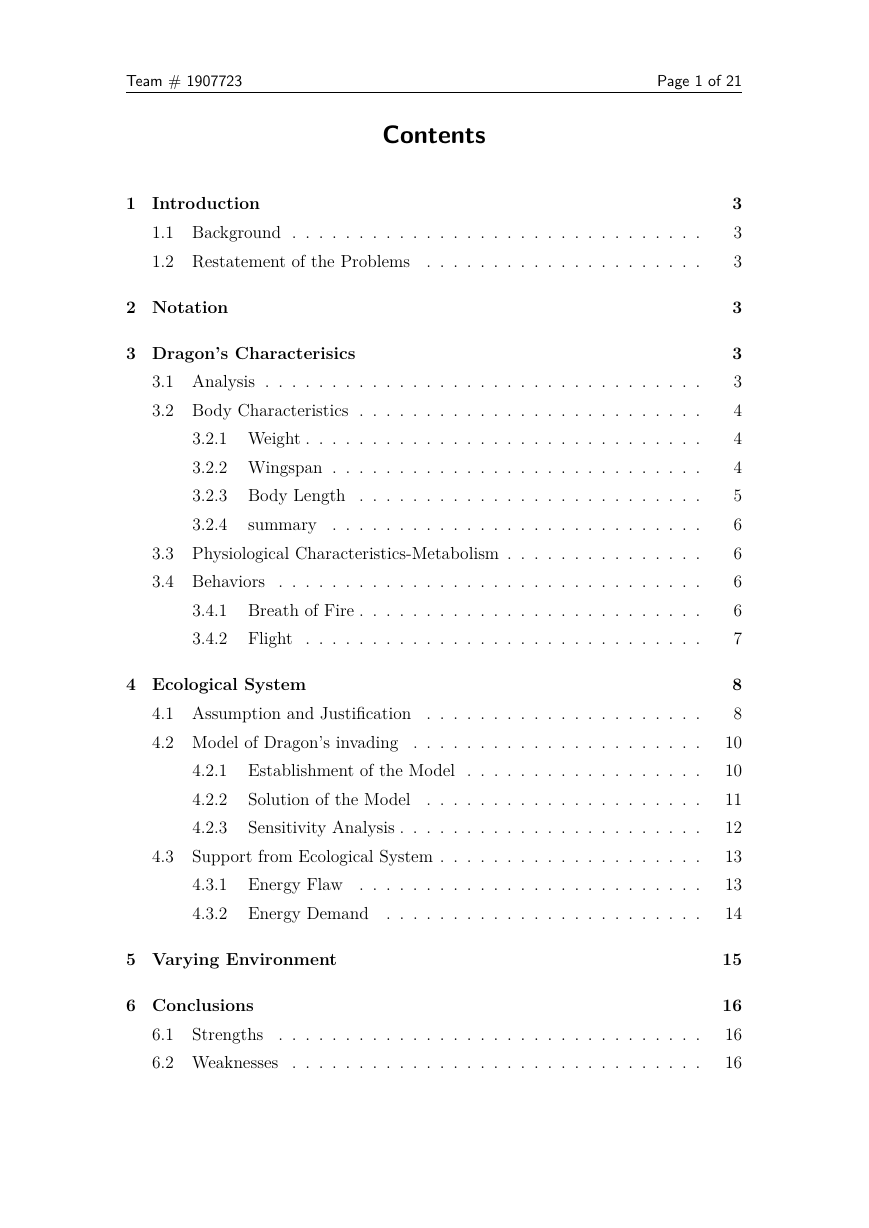
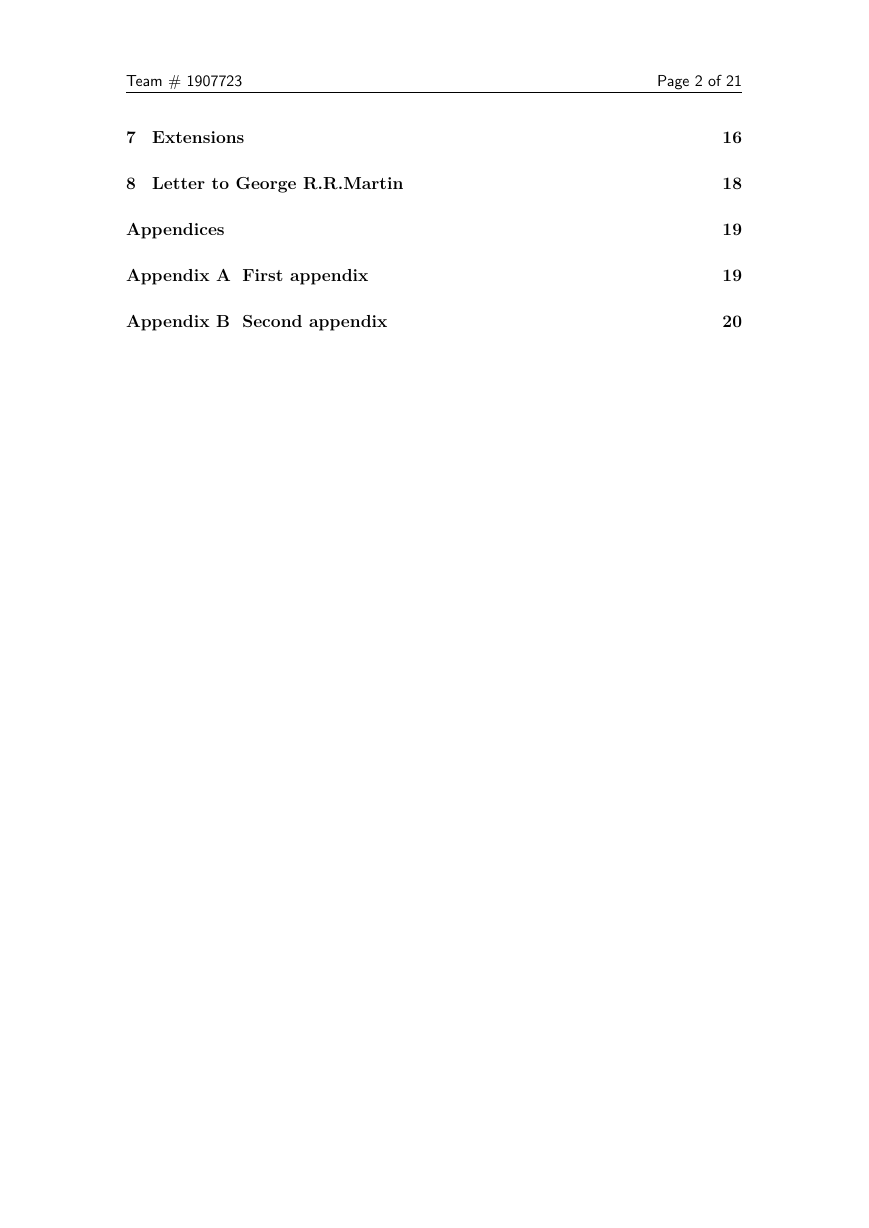
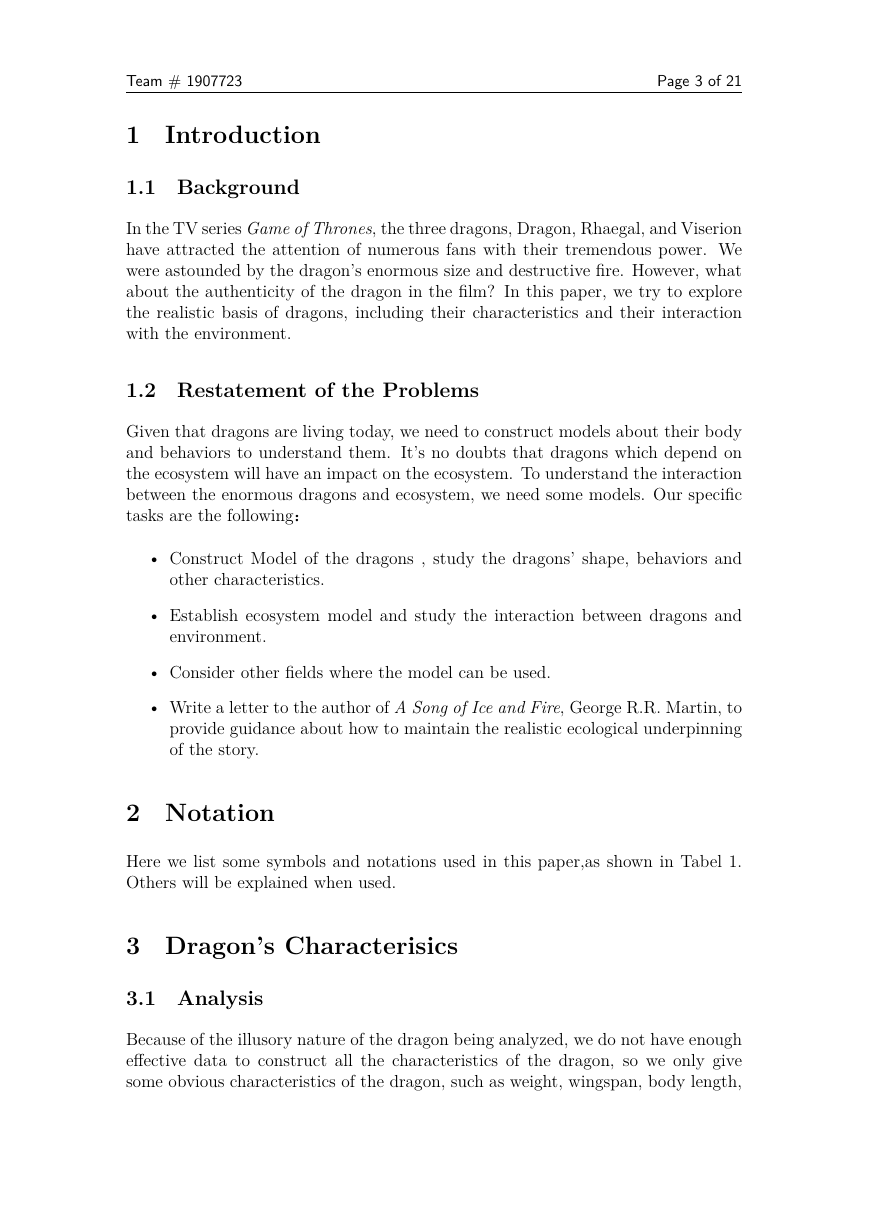
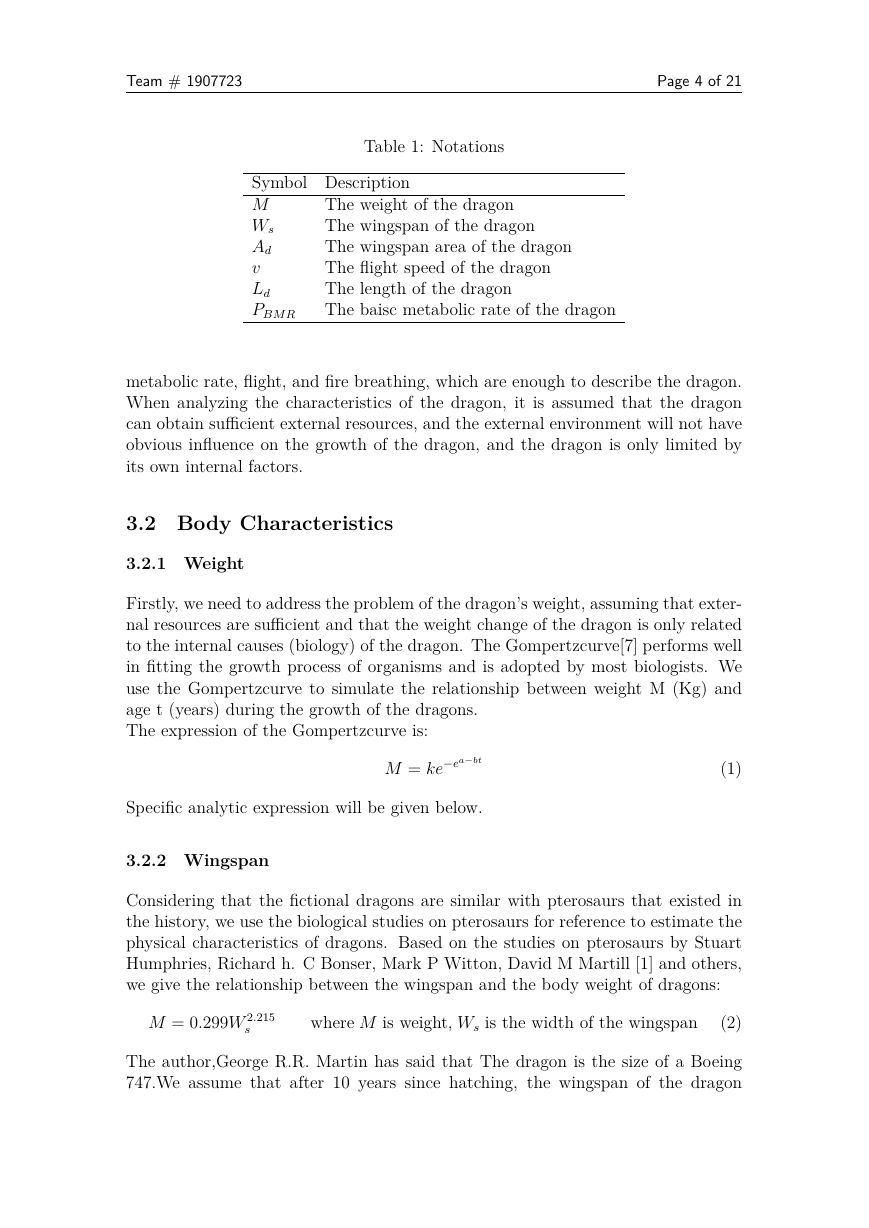
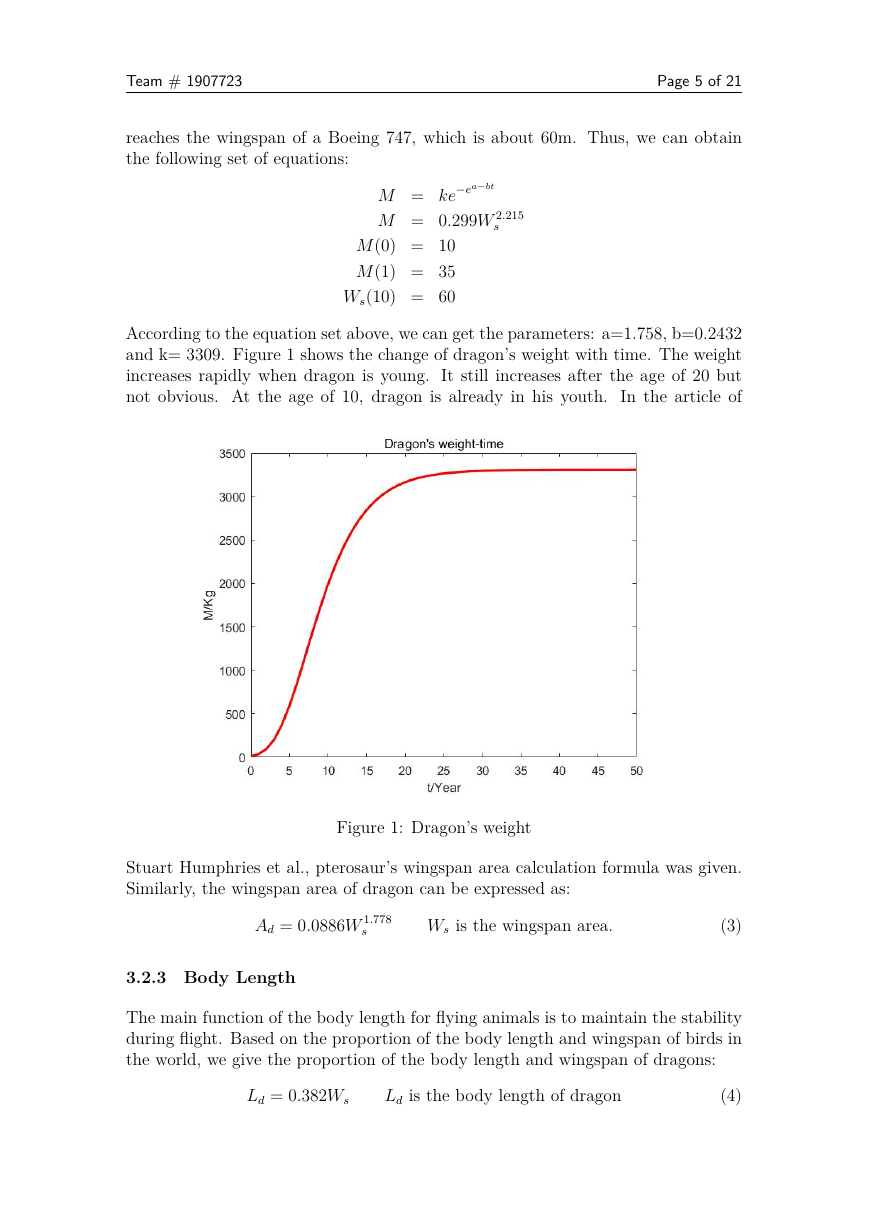
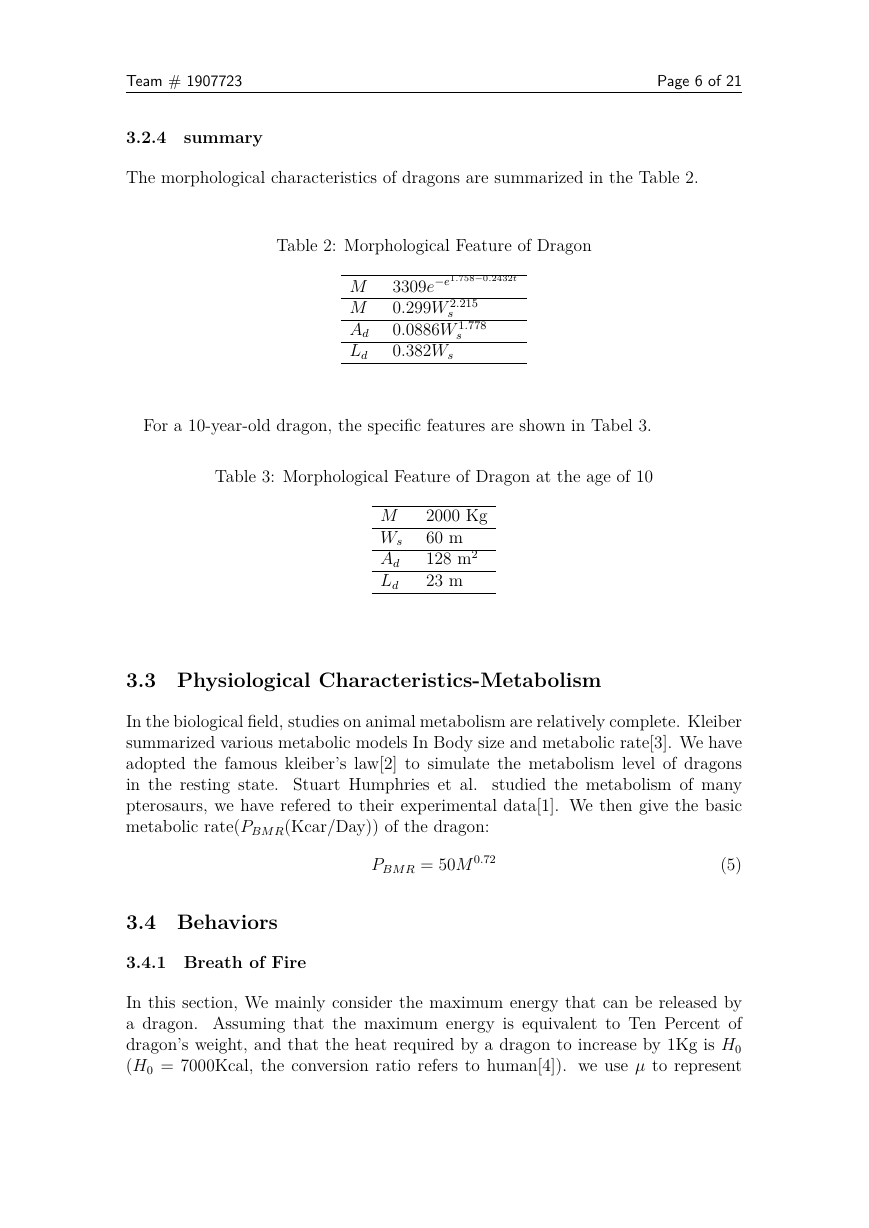
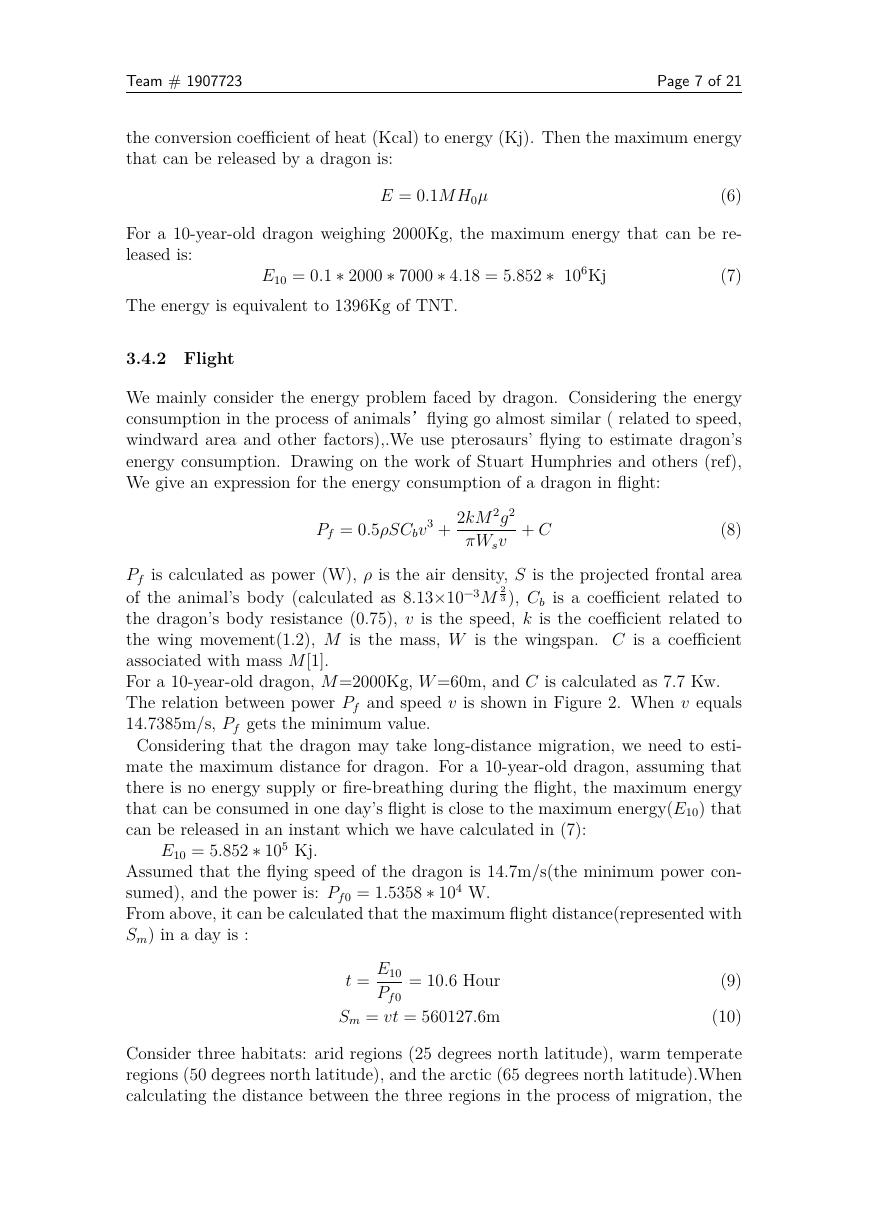








 2023年江西萍乡中考道德与法治真题及答案.doc
2023年江西萍乡中考道德与法治真题及答案.doc 2012年重庆南川中考生物真题及答案.doc
2012年重庆南川中考生物真题及答案.doc 2013年江西师范大学地理学综合及文艺理论基础考研真题.doc
2013年江西师范大学地理学综合及文艺理论基础考研真题.doc 2020年四川甘孜小升初语文真题及答案I卷.doc
2020年四川甘孜小升初语文真题及答案I卷.doc 2020年注册岩土工程师专业基础考试真题及答案.doc
2020年注册岩土工程师专业基础考试真题及答案.doc 2023-2024学年福建省厦门市九年级上学期数学月考试题及答案.doc
2023-2024学年福建省厦门市九年级上学期数学月考试题及答案.doc 2021-2022学年辽宁省沈阳市大东区九年级上学期语文期末试题及答案.doc
2021-2022学年辽宁省沈阳市大东区九年级上学期语文期末试题及答案.doc 2022-2023学年北京东城区初三第一学期物理期末试卷及答案.doc
2022-2023学年北京东城区初三第一学期物理期末试卷及答案.doc 2018上半年江西教师资格初中地理学科知识与教学能力真题及答案.doc
2018上半年江西教师资格初中地理学科知识与教学能力真题及答案.doc 2012年河北国家公务员申论考试真题及答案-省级.doc
2012年河北国家公务员申论考试真题及答案-省级.doc 2020-2021学年江苏省扬州市江都区邵樊片九年级上学期数学第一次质量检测试题及答案.doc
2020-2021学年江苏省扬州市江都区邵樊片九年级上学期数学第一次质量检测试题及答案.doc 2022下半年黑龙江教师资格证中学综合素质真题及答案.doc
2022下半年黑龙江教师资格证中学综合素质真题及答案.doc